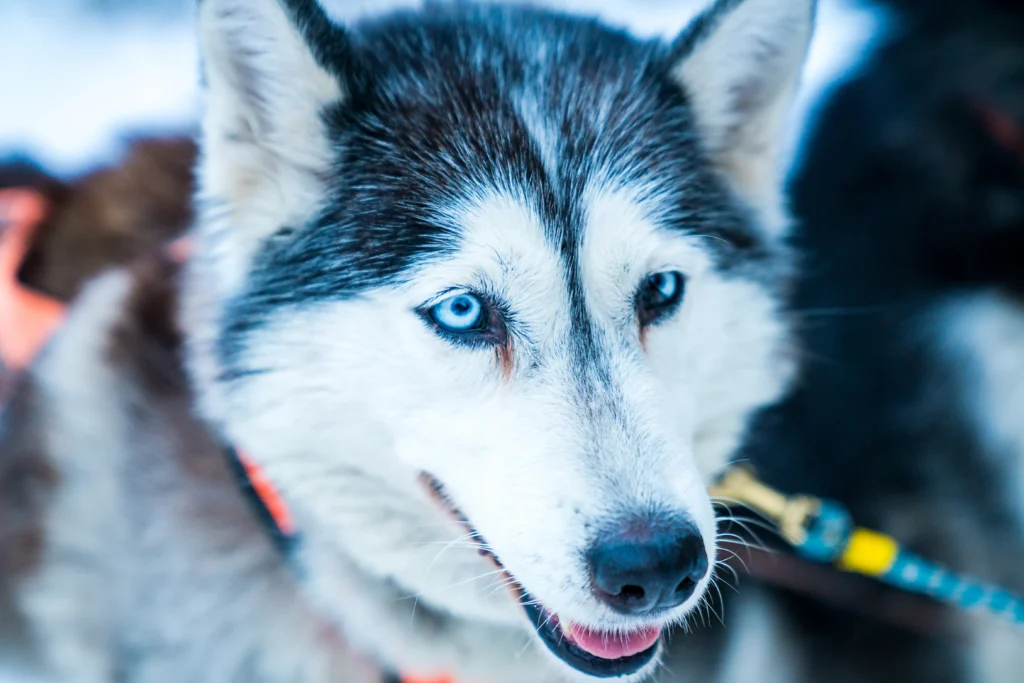The Siberian Husky is a breed that effortlessly captures attention with its wolf-like appearance and piercing blue eyes. These striking eyes, often compared to frozen glaciers or sapphire jewels, have intrigued dog lovers, breeders, and scientists alike. What lies behind this mesmerizing feature? Let us explore the genetics, evolutionary aspects, and myths surrounding this phenomenon while maintaining a rich blend of complexity and sentence variation.
The Genetics Behind Huskies’ Blue Eyes
At the heart of this mystery is a fascinating twist of genetics. Unlike other breeds with more predictable eye colors, the Husky’s blue eyes result from a genetic mutation that sets them apart.
The ALX4 Gene: The Key to Blue Eyes
Scientific breakthroughs have uncovered that the ALX4 gene, located on chromosome 18, plays a pivotal role. A specific mutation in this gene reduces pigmentation in the iris, creating the brilliant blue color. This mutation is dominant, meaning that a Husky only needs one copy of the gene to display this trait. However, not all Huskies with the mutation exhibit blue eyes, underscoring the complexity of genetic interactions.
Dominance, Recessiveness, and Variation
The ALX4 mutation is dominant, yet genetic interplay can produce a spectrum of eye colors. Some Huskies have deep brown eyes, while others flaunt heterochromia—one blue eye paired with a brown one. This variety further elevates their allure, proving that nature loves diversity.
Evolutionary Perspectives: Aesthetic or Functional?
Huskies hail from the frigid landscapes of Siberia, where they were cherished by the Chukchi people for their sledding prowess and companionship. But why the blue eyes? Unlike coat color, which aids in camouflage, blue eyes may not offer a functional advantage. Instead, they could represent a case of aesthetic selection. The Chukchi might have favored dogs with blue eyes for their striking beauty, perpetuating the trait across generations.
Vision and the Blue-Eyed Husky
Do blue eyes impact a Husky’s vision? While misconceptions abound, the reality is more nuanced.
- Light Sensitivity: Blue-eyed Huskies may be slightly more sensitive to bright light. The reduced pigment in their iris allows more sunlight to penetrate, much like pale-colored eyes in humans.
- Night Vision: Despite this, their night vision remains sharp, as it is largely dependent on retinal structure rather than iris pigmentation.
In essence, a Husky’s ability to see—whether in daylight or darkness—remains comparable to that of its brown-eyed counterparts.
Other Breeds With Blue Eyes
Huskies aren’t the sole carriers of this dazzling trait. Blue eyes appear in several breeds, each governed by different genetic mechanisms:
- Australian Shepherds: Often linked to the merle coat gene, their blue eyes are a visual hallmark.
- Border Collies: Like Australian Shepherds, their blue eyes are associated with certain coat patterns.
- Dalmatians: While rare, blue eyes in this breed are sometimes linked to congenital hearing issues.
Debunking Common Myths
Myth 1: All Huskies Have Blue Eyes
This is false. Many Huskies have brown eyes, and some boast the enchanting combination of one blue and one brown eye. This variability highlights the breed’s diverse genetic pool.
Myth 2: Blue Eyes Indicate Blindness
There is no evidence to support this claim. Blue eyes in Huskies are a harmless genetic trait, with no impact on their overall vision.
Caring for a Blue-Eyed Husky
Huskies, regardless of eye color, require attentive care. However, blue-eyed ones may benefit from extra considerations:
- Regular Eye Check-Ups: Periodic vet visits help detect and address potential issues early.
- Protection from Harsh Sunlight: Blue eyes are more light-sensitive, so providing shade during outdoor activities is wise.
- Nutritional Support: Foods rich in omega-3 fatty acids and antioxidants can promote optimal eye health.
Diagram: Genetic Pathway of Blue Eyes in Huskies
mermaidCopy codegraph TD
A[ALX4 Gene Mutation] --> B[Reduced Iris Pigmentation]
B --> C[Blue Eye Appearance]
C --> D[Inheritance to Offspring]
Conclusion
The blue eyes of a Siberian Husky are more than just a physical trait—they are a testament to the breed’s unique genetic legacy and captivating charm. Whether a result of evolutionary aesthetics or genetic quirks, this feature continues to enchant admirers around the world. By understanding the science, dispelling myths, and providing proper care, we can better appreciate the enigmatic beauty of blue-eyed Huskies.
4o



